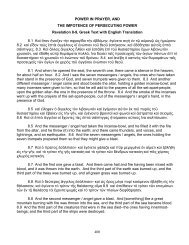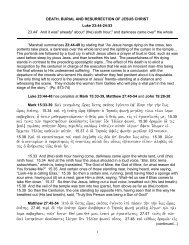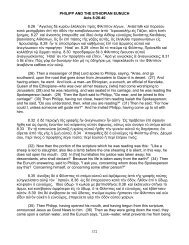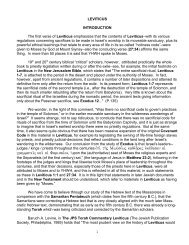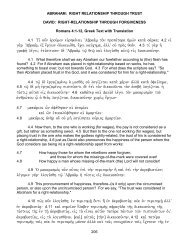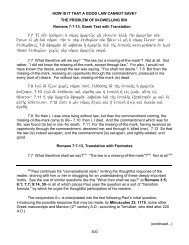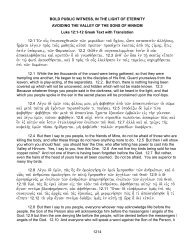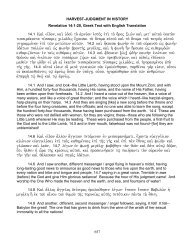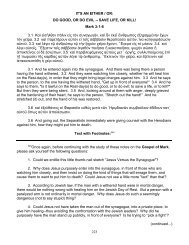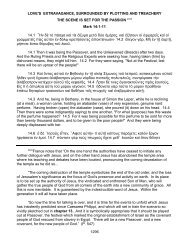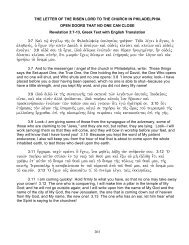Mark 5 - In Depth Bible Commentaries
Mark 5 - In Depth Bible Commentaries
Mark 5 - In Depth Bible Commentaries
You also want an ePaper? Increase the reach of your titles
YUMPU automatically turns print PDFs into web optimized ePapers that Google loves.
amazed. 691690The noun (in the dative) is Äåêáðüëåé, Dekapolei, literally “in (the) Ten City [Area].” Itis the name of a league of originally ten cities, in the area now occupied by Jordan. Itsnorthern boundary was Damascus; its southern boundary was Philadelphia; one of itscities (Scythopolis) was on the western bank of the Jordan River.691Here is a description of one of the earliest “preachers”; his successful proclamationresulted in many (<strong>Mark</strong> again commits the “all-fallacy” here by stating that “everyone wasamazed”) people being attracted to the possibility of a divine manifestation having occurredin Jesus.Anderson thinks that “the Greek verb in ‘they were afraid’ [èáýìáæïí, ethaumazon,rdthe 3 person plural imperfect, literally ‘they were being afraid’] signifies religious awe for<strong>Mark</strong> (see especially 4:41 and 16:8) and would here denote awe before the mystery ofJesus’ authority.” (P. 147)France comments that “Already the foundation has been laid for the extension to theGentiles of the ministry and mission of the Jewish Messiah (13:10; 14:9).” (P. 233)But what shall we make of this story, occurring as it does in such a powerfuldocument as the Gospel of <strong>Mark</strong>?The American preacher, Halford Luccock, admitted frankly, “The story reflects thedemonology of the day, with additional features, resembling a folk story...about demonsconjured into swine, joining unclean spirits with unclean animals...Surely the long andfruitless debate over this story between Huxley and Gladstone, with Huxley rejecting thewhole story and Gladstone defending to the death the literal truth of every detail, points outthe futility of literalist dealing...The chief point is...the calm confidence and courage withwhich Jesus handles the demoniac. All else is secondary. Yet there are validsuggestions, taken not as doctrine, but as first aid to the imagination, picturing theresources of Christ for disordered minds and a society in the grip of evil spirits.” (P. 712)This is quite a subjective judgment; how are we to distinguish between what is“primary” in the story, and what is only “secondary”?Schweizer characterizes the story as “...One of the strangest stories in <strong>Mark</strong>. Onesuspects that an account of a healing by Jesus has been combined with a popular fairytale about a ‘defrauded devil’...An ancient story about Jesus casting out a demon [which]has been enlarged by the addition of various legendary features, but primarily through theaddition of the folksy description of the pigs which rushed into the water.” (Pp. 111-112)Taylor, however, evaluated this story in a much more positive manner: “The manyartless details, the picture of the man smashing his fetters and cutting himself with stones,the dialogue, the expulsion, the description of the man ‘sitting, clothed, and in his rightmind,’ the attitude of the spectators, the kind of message the man proclaimed in theDecapolis, are details taken from life. We have good reason to classify the narrative as(continued...)426




